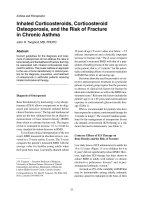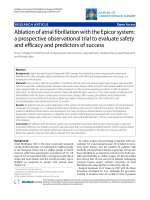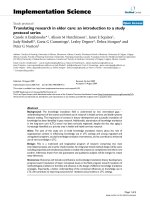Báo cáo y học: " Airway obstruction in asthma: does the response to a deep inspiration matter" pptx
Bạn đang xem bản rút gọn của tài liệu. Xem và tải ngay bản đầy đủ của tài liệu tại đây (44.69 KB, 3 trang )
commentary
review reports research article
ASM = airway smooth muscle; DI = deep inspiration.
Available online />Introduction
Smooth muscle surrounding the airway shortens when it is
activated, and as the muscle shortens the airway narrows.
In normal individuals subjected to challenge with non-spe-
cific contractile agonists, the extent of airway narrowing is
limited and this limited response is reflected by a plateau of
the dose–response curve corresponding to only modest
levels of airway narrowing. Asthmatic individuals, by con-
trast, are hyperresponsive. Compared with the response in
the normal subject, the plateau of the dose–response
curve in the asthmatic is markedly elevated, or abolished
altogether, indicating that airway smooth muscle (ASM)
shortening is limited only by airway closure. It is the marked
elevation of this plateau, or its absence altogether, that
makes asthma such a serious disease [1].
It is presently unclear if the elevated or absent plateau in
asthma is attributable to fundamental changes in the
phenotype of the smooth muscle, structural and/or
mechanical changes in the non-contractile elements within
the airway wall, or alterations in the mechanical coupling
of the airway wall to the surrounding lung parenchyma.
Current evidence suggests that ASM has the force-gener-
ating capacity to close every airway, even in the normal
lung [2,3]. Given the modest level of the plateau response
in the normal lung, it follows that there must be mecha-
nisms at work that act to limit smooth muscle shortening.
Furthermore, it follows that those mechanisms might
become compromised in the asthmatic lung, thereby
accounting for an elevated plateau.
Might the response of the airway to a deep inspiration (DI)
fit into this picture? Maximally activated ASM is subjected
to time-varying mechanical strains associated with tidal
lung inflations and spontaneous DIs. Consequently, acti-
vated ASM must become equilibrated within a dynamic
microenvironment [4]. It is now believed that the dynamic
pattern of muscle stretch that occurs during spontaneous
Commentary
Airway obstruction in asthma: does the response to a deep
inspiration matter?
Jeffrey J Fredberg
Department of Environmental Health, Harvard School of Public Health, Boston, Massachusetts, USA
Correspondence: Jeffrey J Fredberg, Physiology Program, Harvard School of Public Health, 665 Huntington Avenue, Boston, MA 02115, USA.
Tel: +1 617 432 0198; fax: +1 617 432 3468; e-mail:
Abstract
Airway hyperresponsiveness in asthma may not be a problem of too much airway smooth muscle
strength. Rather, it may be a problem of too little of the factors that oppose muscle shortening. The
weight of available evidence seems to support the idea that loss of the dilating response to a deep
inspiration may play a central role in this process, and that the locus of the response is within the
airway smooth muscle cell. Bridge dynamics and plastic reorganization of the smooth muscle
cytoskeleton are the focus of this commentary; how these factors interact and details about underlying
mechanisms remain unclear.
Keywords: bronchospasm, hyperresponsiveness, myosin, plasticity
Received: 1 June 2001
Revisions requested: 28 June 2001
Revisions received: 30 June 2001
Accepted: 16 July 2001
Published: 6 August 2001
Respir Res 2001, 2:273–275
This article may contain supplementary data which can only be found
online at />© 2001 BioMed Central Ltd
(Print ISSN 1465-9921; Online ISSN 1465-993X)
Respiratory Research Vol 2 No 5 Fredberg
breathing engenders a potent dilating effect, and that it is
this dilating effect that accounts for the limited degree of
narrowing that can be attained in the healthy airway during
maximal bronchial provocation [5–8]. The static elastic
load against which the muscle must shorten is apprecia-
ble, especially at high levels of lung inflation [9]. At modest
levels of lung inflation, however, in the absence of tidal
loading, this static load seems to be insufficient by itself to
prevent airway closure [2,3,10]. There exists also a bron-
choprotective effect of DIs that is perhaps even more
important than the bronchodilating response; a DI prior to
agonist exposure blunts the subsequent contractile
response [11].
Dynamically equilibrated states
We breathe all the time and we sigh at the rate of about 10
times per hour. The expected physiologic range of tidal
muscle stretch during breathing is from about 4% of
muscle length during spontaneous breathing at rest to
12% during a sigh, and greater still during exercise. In
comparison, the tidal stretch of ASM corresponding to 3%
of muscle length is enough to inhibit force generation by
50% and is equipotent in that regard with concentrations
of isoproterenol, a potent relaxing agonist, in the range
10
–7
to 10
–5
M [12]. In healthy volunteers who inhale bron-
choconstricting substances such as histamine there is a
reflex increase in the frequency and depth of spontaneous
sighs, and these DIs cause prompt and nearly complete
dilation of the airway [6,13]. In studies of the canine lung,
Loring et al have shown that the locus of the decrease of
lung resistance caused by a DI is within peripheral airways
rather than central airways or the lung tissue [14].
Deep inspirations: friend or foe?
These bronchodilating and bronchoprotective effects of a
DI fail in the asthmatic [8,11,15]. Ingram provides functional
evidence to show that, if anything, DIs only serve to make
matters worse during a spontaneous asthmatic attack [13],
and this conclusion has been reinforced by recent high res-
olution computed tomographic reconstructions of airway
geometry in mild asthmatics before, during and after a DI
[16]. It is not clear, however, what fraction of that response
might be myogenic. Orehek et al speculated about the exis-
tence of a vicious circle in which asthmatic airway obstruc-
tion causes a reflex increase in the frequency of DIs, and
DIs in turn make the obstruction worse [6]. Fish et al
observed that airway obstruction in asthma behaves as if it
were caused by an inability of DIs to dilate constricted
airways, as opposed to an increased responsiveness of the
airway itself [5]. Remarkably, Salter had come to the much
the same conclusion more than 120 years earlier [17].
Failure of the airway to stretch due to
mechanical uncoupling?
This impairment of the bronchodilating effect of a DI was
long thought to be a characteristic of only spontaneous
asthmatic obstruction and the late-phase response to
allergen challenge [13,18]. Nonetheless, a similar impair-
ment is easily induced in healthy subjects merely by pro-
hibiting DIs. Prohibition of DIs was first undertaken as a
rough model of mechanical uncoupling of ASM from the
mechanical loads attributable to parenchymal tethering
and lung elastic recoil [8]. Several laboratories have sub-
sequently confirmed that, if healthy non-asthmatic, non-
allergic subjects do nothing more than to voluntarily refrain
from DIs but otherwise maintain normal tidal volume,
minute ventilation and functional residual capacity, their
airways become hyperresponsive [8,15,19,20]. When DIs
are eventually reinstated, the subsequent ability of DIs to
dilate the airways becomes impaired, as it does in sponta-
neous asthmatic obstruction [8,19,20]. Prohibition of DIs
during bronchial challenge of healthy subjects, however,
makes their dose–response curves similar but not equiva-
lent to that of asthmatic subjects [15,21]. As shown
clearly by Brusasco et al [15], airway hyperresponsive-
ness is not just a problem of lack of dilation with a DI.
It’s about time
King et al showed that responsiveness of healthy subjects
continue to increase for up to 15 min after prohibition of
DIs [20]. Data obtained in isolated smooth muscle shows,
similarly, that muscle responses to imposed load fluctua-
tions (simulating the mechanical action of tidal breathing)
become dynamically equilibrated with a time constant in
the order of 10 min. The data also show that isotonic
shortening is not completed for many tens of minutes after
muscle activation [4]. Myosin binding is slow to become
dynamically equilibrated in a dynamic microenvironment,
certainly orders of magnitude slower than in an isometric
contraction [4]. Thus, if the muscle is to become so stiff
that it fails to respond to a DI, it must take a relatively long
time to attain that frozen contractile state [4].
The issue of time also comes into play with considerations
of cytoskeletal plasticity. The cytoskeleton of ASM is con-
tinuously adapting to its dynamic microenvironment, and
these cytoskeletal-remodeling events seem to play out
over a wide range of time scales. Gunst and Wu [22] have
shown that muscle force can display an almost immediate
sensitivity to the length history, whereas Pratusevich et al
have shown that other remodeling processes play out for
at least many tens of minutes [23,24].
How much does ASM stretch
in vivo
?
Do differences in ASM stretch account for differences in
the response to a DI? The ability of lung inflation to stretch
ASM versus its failure to do so has been suggested as a
likely mechanism to account for bronchodilating versus
bronchoconstricting effects of a DI, but it now seems that
this may not be the case. Recent data from two laborato-
ries have confirmed that healthy subjects challenged with
a spasmogen display substantial bronchodilation following
commentary
review reports research article
a DI, whereas asthmatics either fail to dilate their airway in
response to a DI or, more often, exhibit further bron-
choconstriction [16,19]. These new data imply, however,
that peak mechanical strains in the airway wall during the
DI are in excess of 50% in both the normal and the asth-
matic subject, even when the smooth muscle is activated.
If transient strains of that magnitude were actually trans-
mitted undiminished from the airway wall to the contractile
units within ASM cells, then all bridges would surely be
disrupted, even in the asthmatic airway. One potential
explanation for the absence of a dilatory response in the
asthmatic might be that myosin bridges never see strains
that large. This is perhaps because the majority of the
mechanical strain in the asthmatic airway during a DI is
taken up by increased extensibility of the extracellular
matrix, by the intracellular series elastic component, or by
the cytoskeletal scaffolding within which the myosin motor
operates. At present, however, there are no data available
that can address this possibility.
Conclusion
The potent dilating response to a DI observed in normal
individuals fails in asthmatics. Bridge dynamics and plastic
reorganization of the cytoskeleton are surely important
factors, but how they interact and details about underlying
mechanisms remain unclear. Muscle shortening velocity
also seems to be an important factor [4,25,26]. In addi-
tion, Permutt and colleagues have suggested that the
bronchodilating and the bronchoprotective effects of DIs
may be connected to the release from non-adrenergic,
non-cholinergic nerves of an endogenous dilating sub-
stance such as nitric oxide [11]. Taken together, the
weight of available evidence seems to support the idea
that loss of the dilating response to a DI may indeed play a
central role in airway obstruction in asthma. However, no
clear picture has yet emerged to account for the constella-
tion of curious findings that is associated with responses
of the airways to DIs.
References
1. Macklem PT: Bronchial hyperresponsiveness. Chest 1987, 91:
189S-191S.
2. Brown RH, Mitzner W: Airway closure with high PEEP in vivo. J
Appl Physiol 2000, 89:956-960.
3. Gunst SJ, Warner DO, Wilson TA, Hyatt RE: Parenchymal inter-
dependence and airway response to methacholine in excised
dog lobes. J Appl Physiol 1988, 65:2490-2497.
4. Fredberg, JJ, Inouye DS, Mijailovich SM, Butler JP: Perturbed
equilibrium of myosin binding in airway smooth muscle and
its implications in bronchospasm. Am J Respir Crit Care Med
1999, 159:1-9.
5. Fish JE, Ankin MG, Kelly JF, Peterman VI: Regulation of bron-
chomotor tone by lung inflation in asthmatic and nonasth-
matic subjects. J Appl Physiol: Respir Environ Exercise Physiol
1981, 50:1079-1086.
6. Orehek J, Charpin D, Velardocchio JM, Grimaud C: Bronchomo-
tor effect of bronchoconstriction-induced deep inspirations in
asthmatics. Am Rev Respir Dis 1980, 21:297-305.
7. Shen X, Gunst SJ, Tepper RS: Effect of tidal volume and fre-
quency on airway responsiveness in mechanically ventilated
rabbits. J Appl Physiol 1997, 83:1202-1208.
8. Skloot G, Permutt S, Togias A: Airway hyperresponsiveness in
asthma: a problem of limited smooth muscle relaxation with
inspiration. J Clin Invest 1995, 96:2393-2403.
9. Ding D J, Martin JG, Macklem PT: Effects of lung volume on
maximal methacholine-induced bronchoconstriction in
normal humans. J Appl Physiol 1987, 62:1324-1330.
10. Mitzner W, Brown RH: Potential mechanism of hyperrespon-
sive airways. Am J Respir Crit Care Med 2000, 161:1619-1623.
11. Scichilone N, Permutt S, Togias A: The lack of the bronchopro-
tective and not the bronchodilatory ability of deep inspiration
is associated with airway hyperresponsiveness. Am J Respir
Crit Care Med 2001, 163:413-419.
12. Gump A, Haughney L, Fredberg JJ. Relaxation of activated
airway smooth muscle: relative potency of isoproterenol
versus tidal stretch. J Appl Physiol 2001, 90:2306–2310.
13. Ingram RH Jr: Relationship among airway–parenchymal inter-
actions, lung responsivness, and inflammation in asthma.
Chest 1995, 107(3):148S-152S.
14. Loring SH, Ingram RH Jr, Drazen JM: Effects of lung inflation on
airway and tissue responses to aerosol histamine. J Appl
Physiol: Respir Environ Exercise Physiol 1981, 51:806-811.
15. Brusasco V, Crimi E, Barisione G, Spanevello A, Rodarte JR, Pel-
legrino R: Airway responsiveness to methacholine: effects of
deep inhalations and airway inflammation. J Appl Physiol
1999, 87:567-573.
16. Brown RH, Scichilone N, Mudge B, Diemer FB, Permutt S, Togias
A: High-resolution computed tomographic evaluation of
airway distensibility and the effects of lung inflation on airway
caliber in healthy subjects and individuals with asthma. Am J
Respir Crit Care Med 2001, 163:994–1001.
17. Salter HH: On asthma: its pathology and treatment, 1859. In
The Evolution of Understanding. Edited by Brewis RAL. London:
Science Press Limited; 1990:106-142. [Classic Papers in
Asthma, vol 1.]
18. Pellegrino R, Violante B, Crimi E, Brusasco V: Effects of deep
inhalation during early and late asthmatic reactions to aller-
gen. Am Rev Respir Dis 1990, 142:822-825.
19. Jensen A, Atileh H, Suki B, Ingenito EP, Lutchen KR: Airway
caliber in healthy and asthmatic subjects: effects of bronchial
challenge and deep inspirations. J Appl Physiol 2001, 91:
506–515.
20. King GG, Moore BJ, Seow CY, Pare PD: Time course of
increased airway narrowing caused by inhibition of deep
inspiration during methacholine challenge. Am J Respir Crit
Care Med 1999, 160:454-457.
21. Burns GP, Gibson GJ: Airway hyperresponsiveness in asthma.
Not just a problem of smooth muscle relaxation with inspira-
tion. Am J Respir Crit Care Med 1998, 158:203-206.
22. Gunst SJ, Wu MF. Plasticity of airway smooth muscle stiffness
and extensibility: role of length-adaptive mechanisms. J Appl
Physiol 2001, 90:741-749.
23. Pratusevich VR, Seow CY, Ford LE: Plasticity in canine airway
smooth muscle. J Gen Physiol 1995, 105:73-94.
24. Seow CY, Pratusevich VR, Ford LE. Series-to-parallel transition
in the filament lattice of airway smooth muscle. J Appl Physiol
2000, 89:869-876.
25. Fan T, Yang M, Halayko A, Mohapatra SS, Stephens NL: Airway
responsiveness in two inbred strains of mouse disparate in
IgE and IL-4 production. Am J Respir Cell Mol Biol 1997, 17:
156-163.
26. Duguet A, Biyah K, Minshall E, Gomes R, Wang CG, Taoudi-
Benchekroun M, Bates JHT, Eidelman DH: Bronchial respon-
siveness among inbred mouse strains. Role of airway
smooth-muscle shortening velocity. Am J Respir Crit Care
Med 2000, 161:839-848.
Available online />









